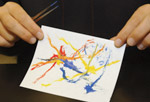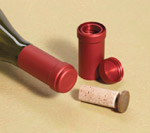By Teri Bachman
TASTE TEST
Just how do you judge the quality of a university? Faculty-student ratio? Research dollars received? Library holdings? How about . . . chicken strips?
That worked for Valerie Frankel ’02 when she was trying to decide which college to attend. “When my daughter was looking at colleges, she had difficulty seeing the difference between them, and every one offered a degree in her chosen field, English lit,” her mom, Donna, told Kim Boatman at the San Jose Mercury News. So Valerie decided to use her favorite meal as the deciding factor, ordering chicken strips at each campus she visited. UC Davis was the clear winner, reported Donna, adding that her daughter enrolled, graduated and now has a brother attending. Donna recommends the chicken strip method for all undecideds: “After all, you won’t have the same teacher every quarter, but you will eat every day.”
AS THE WORMS TURN
In considering the lowly maggot, some may think of the grave. Some may think of road kill. Some may think of art! Especially students in Diane Ullman’s Entomology 1 class who this fall used the little squirmers to make paintings. They were participating in Maggot Art, an interactive outreach program that teaches about this important forensic and medical tool. Maggot Art is the brainchild of Rebecca Bullard, a graduate student in entomology, who after many, many hours of raising maggots thought, “What would happen if they were dipped in paint?” and went on to develop an outreach program geared toward kindergarten-through-fourth-grade students to supplement their study of life cycles. Though the college students were a bit past the target age, they seemed to enjoy the presentation. Said one: “This is the most fun with maggots I’ve ever had!”
CREATIVITY UNLEASHED
The fun part of research is in the details, says Science News, which found a lot of fun in UC Davis graduate student Ron Swaisgood’s study of the ways that ground squirrels assess snakes as threats. To conduct the project, Swaisgood needed to tether a rattlesnake so that it could move and strike, but not escape. “Depending on how you look at them, snakes have no neck or nothing but neck,” pointed out Science News. But Swaisgood turned to a time-honored solution: fishing line attached to the snake with—what else—duct tape. Swaisgood, M.S. ’90, Ph.D. ’94, is now putting his ingenuity to work at the San Diego Zoo.
HOPE FOR THE UNDERACHIEVING
Rosalie Vanderhoef, the wife of Chancellor Larry, shared some lesser-known facts about her husband for a skit about his life—performed at an Arts and Business Council of Sacramento awards ceremony honoring him for his leadership on the Mondavi Center. Not only did our head guy have an early passion for billiards, we learned, but as a student he was once put on academic probation. (He got off.)
CAN'T TOP THIS
 Sure, we wine drinkers know that a screw top is more convenient—but who can get past that Boone’s Farm aesthetic? Retired engineering professor William Gardner has found a way. He has invented Metacork—a product that retains the romance of the cork but eliminates the hassle. MetaCork looks much like the traditional cork and outer sleeve, but the sleeve functions as an opener—just twist and the cork comes out. Then, when cork and sleeve are removed, a handy reseal cap remains. Gardner calls it “the perfect marriage of tradition and technology.” We call it handy.
Sure, we wine drinkers know that a screw top is more convenient—but who can get past that Boone’s Farm aesthetic? Retired engineering professor William Gardner has found a way. He has invented Metacork—a product that retains the romance of the cork but eliminates the hassle. MetaCork looks much like the traditional cork and outer sleeve, but the sleeve functions as an opener—just twist and the cork comes out. Then, when cork and sleeve are removed, a handy reseal cap remains. Gardner calls it “the perfect marriage of tradition and technology.” We call it handy.

